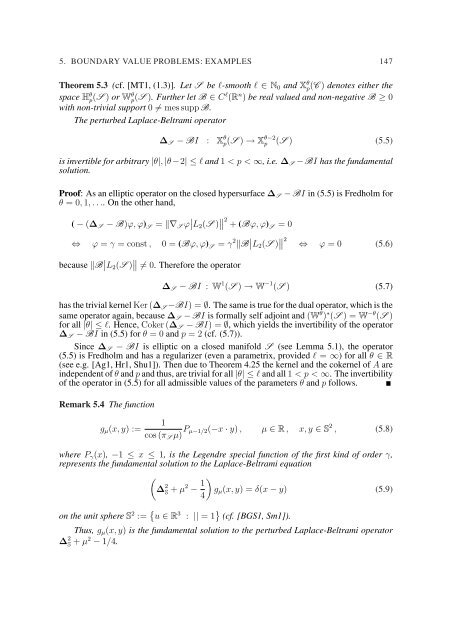EQUATIONS OF ELASTIC HYPERSURFACES
EQUATIONS OF ELASTIC HYPERSURFACES
EQUATIONS OF ELASTIC HYPERSURFACES
Create successful ePaper yourself
Turn your PDF publications into a flip-book with our unique Google optimized e-Paper software.
5. BOUNDARY VALUE PROBLEMS: EXAMPLES 147<br />
Theorem 5.3 (cf. [MT1, (1.3)]. Let S be l-smooth l ∈ N 0 and X θ p(C ) denotes either the<br />
space H θ p(S ) or W θ p(S ). Further let B ∈ C l (R n ) be real valued and non-negative B ≥ 0<br />
with non-trivial support 0 ≠ mes supp B.<br />
The perturbed Laplace-Beltrami operator<br />
∆ S − BI : X θ p(S ) → X θ−2<br />
p (S ) (5.5)<br />
is invertible for arbitrary |θ|, |θ−2| ≤ l and 1 < p < ∞, i.e. ∆ S −BI has the fundamental<br />
solution.<br />
Proof: As an elliptic operator on the closed hypersurface ∆ S − BI in (5.5) is Fredholm for<br />
θ = 0, 1, . . .. On the other hand,<br />
( − (∆ S − B)ϕ, ϕ) S = ‖∇ S ϕ ∣ ∣ L2 (S ) ∥ ∥ 2 + (Bϕ, ϕ) S = 0<br />
⇔ ϕ = γ = const , 0 = (Bϕ, ϕ) S = γ 2 ‖B ∣ ∣ L2 (S ) ∥ ∥ 2 ⇔ ϕ = 0 (5.6)<br />
because ‖B ∣ ∣ L2 (S ) ∥ ∥ ≠ 0. Therefore the operator<br />
∆ S − BI : W 1 (S ) → W −1 (S ) (5.7)<br />
has the trivial kernel Ker (∆ S −BI) = ∅. The same is true for the dual operator, which is the<br />
same operator again, because ∆ S − BI is formally self adjoint and (W θ ) ∗ (S ) = W −θ (S )<br />
for all |θ| ≤ l. Hence, Coker (∆ S − BI) = ∅, which yields the invertibility of the operator<br />
∆ S − BI in (5.5) for θ = 0 and p = 2 (cf. (5.7)).<br />
Since ∆ S − BI is elliptic on a closed manifold S (see Lemma 5.1), the operator<br />
(5.5) is Fredholm and has a regularizer (even a parametrix, provided l = ∞) for all θ ∈ R<br />
(see e.g. [Ag1, Hr1, Shu1]). Then due to Theorem 4.25 the kernel and the cokernel of A are<br />
independent of θ and p and thus, are trivial for all |θ| ≤ l and all 1 < p < ∞. The invertibility<br />
of the operator in (5.5) for all admissible values of the parameters θ and p follows.<br />
Remark 5.4 The function<br />
g µ (x, y) :=<br />
1<br />
cos (π S µ) P µ−1/2(−x · y) , µ ∈ R , x, y ∈ S 2 , (5.8)<br />
where P γ (x), −1 ≤ x ≤ 1, is the Legendre special function of the first kind of order γ,<br />
represents the fundamental solution to the Laplace-Beltrami equation<br />
(<br />
∆ 2 S + µ 2 − 1 )<br />
g µ (x, y) = δ(x − y) (5.9)<br />
4<br />
on the unit sphere S 2 := { u ∈ R 3<br />
: || = 1 } (cf. [BGS1, Sm1]).<br />
Thus, g µ (x, y) is the fundamental solution to the perturbed Laplace-Beltrami operator<br />
∆ 2 S + µ 2 − 1/4.

















